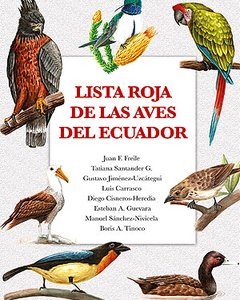Authors:
Juan F. Freile, Tatiana Santander, Gustavo Jiménez-Uzcátegui, Luis Carrasco, Diego Cisneros-Heredia, Esteban A. Guevara, Manuel Sánchez-Nivicela y Boris A. Tinoco
Affiliations:
Comité Ecuatoriano de Registros Ornitológicos, Red Aves Ecuador, Aves y Conservación, Charles Darwin Research Station, Charles Darwin Foundation, Ministerio del Ambiente, Universdiad San Francisco de Quito y Universidad del Azuay
Abstract:
The Red List is a tool for management and scientific institutions to determine conservation priorities. The previous version was made in 2002, where only 247 species were incorporated. The IUCN recommends that the upgrade be performed every 5-10 years. Therefore, updating the Ecuadorian Red Bird List, both at the continental and Galapagos list, a a priority.
A total of 1508 species (1447 of the continent, 61 Galapagos) were studied. This work began in 2014 with studies prepared by the authors and subsequently endorsed and discussed in several workshops with ornithologists and scientists working with birds in Ecuador. The reason for the number being so high is because many species recorded in the previous Red List were upgraded to threat status, and a large number of species enter this list.
Además, se observa el impacto que muchos hábitats han tenido debido a su degradación, donde las poblaciones de aves han disminuido radicalmente. En caso de Galápagos es dramático, porque de 61 taxones evaluados, 42 (69%) están en riesgo de extinción en las islas, de los cuales, 26 son especies endémicas y nueve son subespecies endémicas para las islas. Esta herramienta es clave para las prioridades de manejo en el presente, la cual debe ser actualizada cada 5 años y con un mayor involucramiento activo de la comunidad ornitológica.
In addition, the impact that many habitats have had due to their degradation, where bird populations which have declined radically. In case of Galapagos is dramatic, because of 61 taxa evaluated, 42 (69%) are at risk of extinction on the islands, of which 26 are endemic species and nine are subspecies endemic to the islands. This tool is key to management priorities in the present, which must be updated every 5 years and with greater active involvement of the ornithological community.
Language:
Spanish




